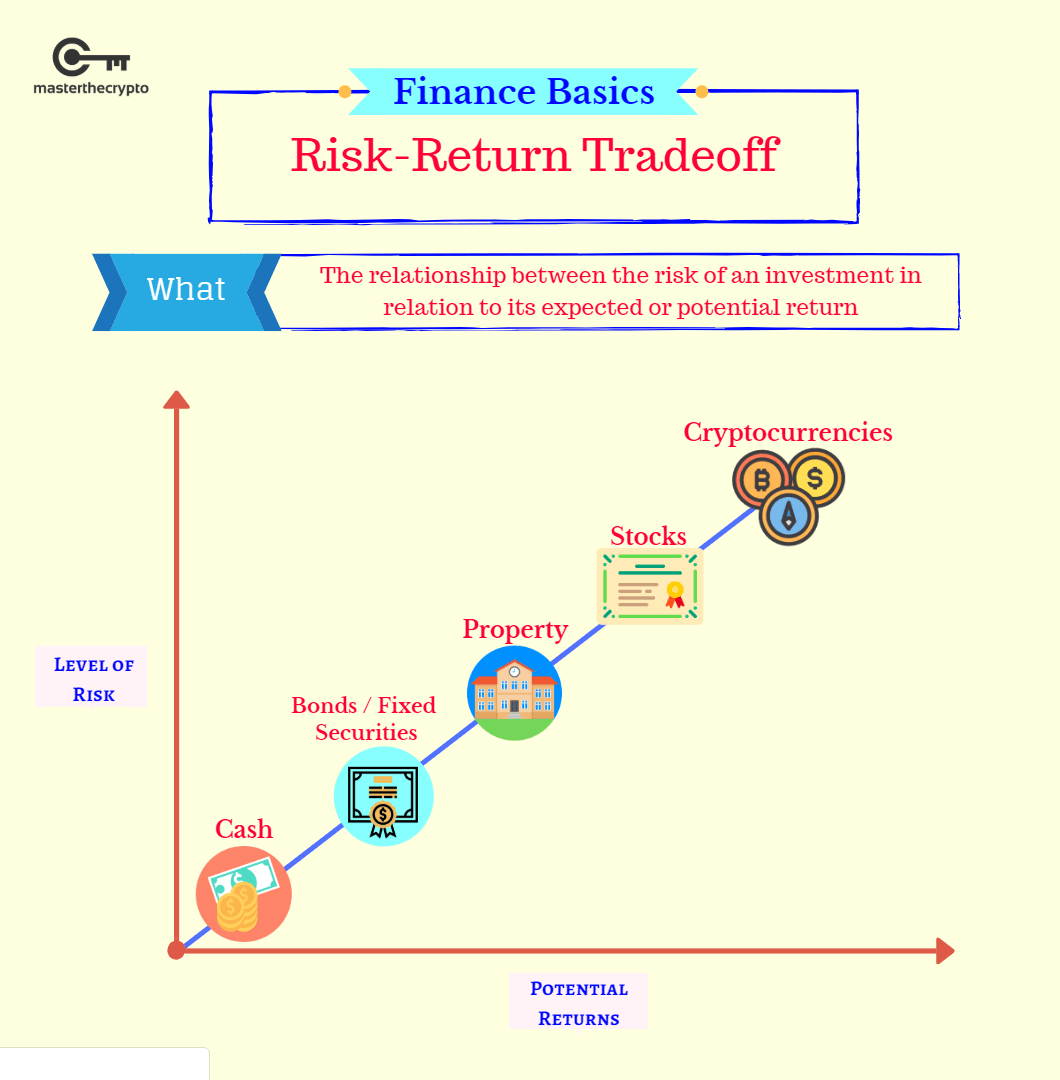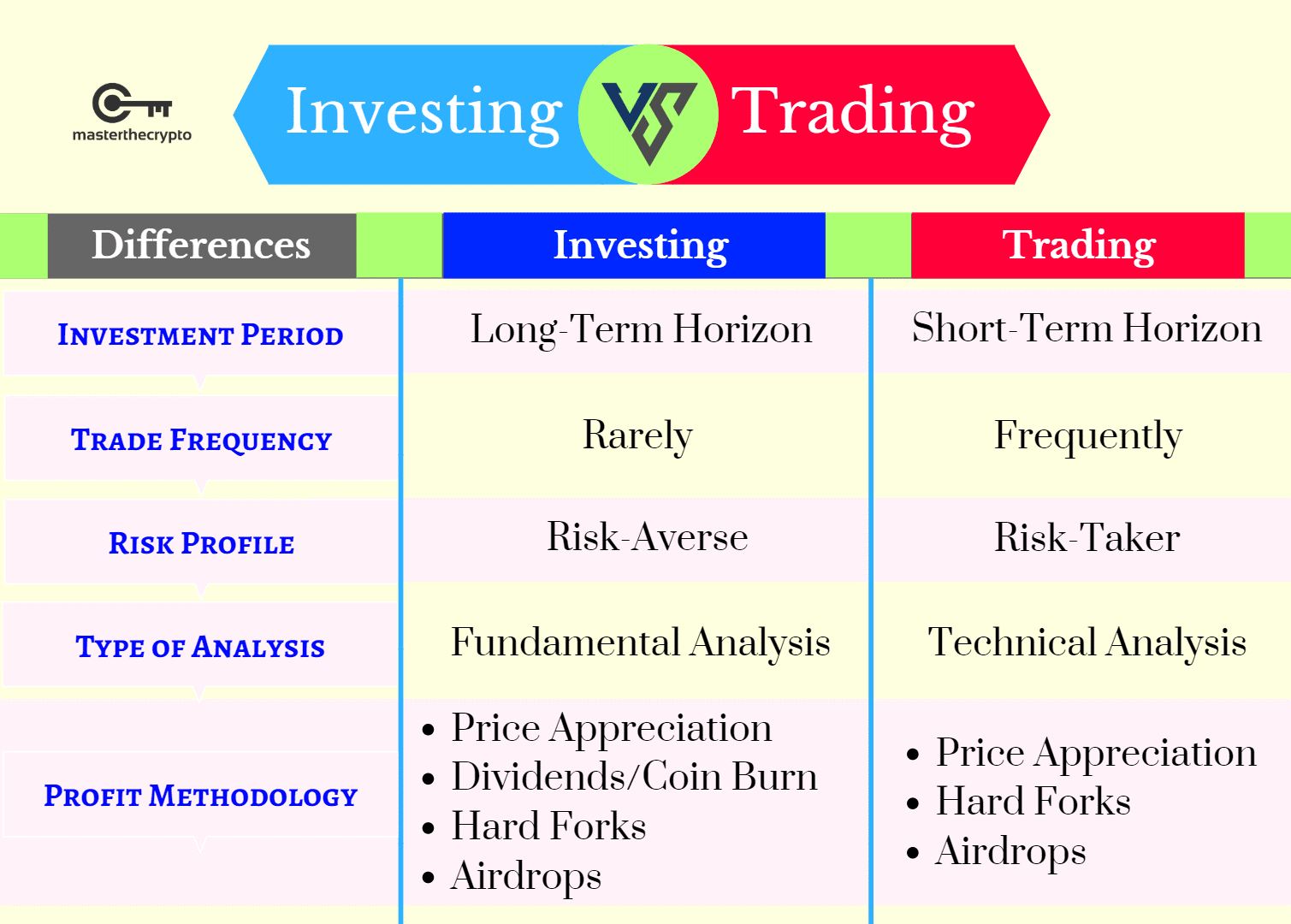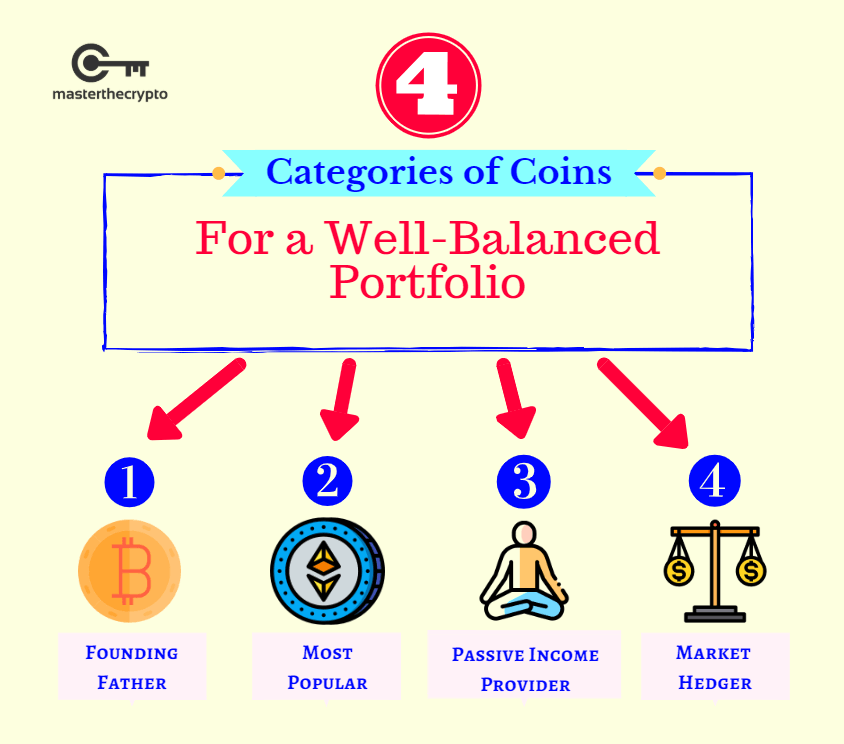This guide will take a look at 4 types of coins to diversify your crypto portfolio & manage risks in the extremely volatile cryptocurrency market.

In the volatile world of cryptocurrency trading, it is important to implement some strategies needed to manage your cryptocurrency investments. Managing your investments well means that your portfolio of coins is protected against risk. This guide will explore the different type of coins you should hold in order for you to manage a well-balanced investment portfolio.
A portfolio is a term that represents the collection of all investments you own across all types of investment assets. If you only own 10 types of coins and tokens, then your portfolio consists of only the 10 cryptocurrencies. It is much better to own different kinds of investments across different categories. For instance, having a portfolio consisting of a mix of cryptocurrency coins, stocks, and bonds.
Let’s start the ball rolling by understanding the most important concept in investing, called ‘Risk’.
(Read more: Analyzing Cryptocurrency Risk: Existing Coins vs ICO)
What is Risk?
Risk is defined as the possibility of loss that an investor is willing to take in exchange for the possibility of gains from his investments.
There are generally two types of risk in the cryptocurrency market:
-
Market (Systematic) Risk
Market risk is the risk associated with the overall performance of the cryptocurrency markets. Market risks cannot be eliminated. If you’ve been an investor in the cryptocurrency space since the start of 2018, you will understand that the cryptocurrency market is highly correlated to Bitcoin and each other. The entire market crashed at the start of 2018 after a tremendous run in 2017, and no matter which coins you invested in, almost all coins and tokens experienced massive losses. This is an example of market risk.
-
Coin-Specific (Idiosyncratic) Risk
Coin-specific risk refers to the isolated risk of a single coin or token in the cryptocurrency market, influenced by factors specific to the project itself. If for example, a project experiences a negative event (such as network failure or running away with investors’ funds), then the coin holder that invested in that project will be a victim to the project-specific risk. Coin-specific risk can be reduced through diversification.
The fact is that in the investment marketplace, risks is as much an incentive as it is a red flag. Conventional financial wisdom states that the higher the risk, the greater the expected returns. It’s no surprise that cryptocurrencies are the riskiest investments you can make.

(See also: Crypto ICO vs. Stock IPO: What’s the Difference?)
Key Factors to Consider When Investing
Let’s take a look at several key factors that you need to consider when investing in cryptocurrencies.
-
Timing
As you build your cryptocurrency trading portfolio, it is vital to take into consideration the basic elements of tokens and coins trading. In understanding the timing element, you are well-placed to know what to do when the market goes red and movement is trending downwards.
The common principle here is to buy when the bears take over (when the market is down) and sell when the bulls are raging (when the market is up). The key concern here is not about the predictability of market price, rather, it is knowing the action to take in the face of prevailing circumstances.
“The time to buy is when there's blood in the streets.”
– Baron Rothschild
(Read also: Guide to Cryptocurrency Liquidity: Understanding Liquidity & Its Importance)
-
Investing vs Trading

Research must be undertaken before investing in anything, especially if you’re planning to invest only in cryptocurrencies. There’s over 2,000 coins and tokens to choose from and the crazy volatility of the cryptocurrency market can set you up for an uncomfortable ride. In the investing world, there are two main types of analysis: Fundamental analysis and Technical analysis.
Investors often use fundamental analysis to evaluate the long-term prospects and viability of a cryptocurrency. A trader, on the other hand, would utilize technical analysis by studying price charts, patterns, signals and indicators to make short-term decisions. Knowing which type of individual you are and the types of risk you’re comfortable with is key to understanding which type of analysis you should employ. Short-term trading is riskier due to the volatility of the markets.
(Read also: Guide To Cryptocurrency Trading Basics: Do Charts & Technical Analysis Really Work?)
-
Personal Competency
One other key consideration that will help your cryptocurrency investment portfolio is to focus on your core competencies and strengths. Some question you can ask yourself:
- What coins and tokens do you research?
- In which sector are you best grounded?
- Do you understand utility tokens, or is it security tokens you know best?
In building a competence cycle for yourself, you get grounded in the tokens and coins that will work best for you. No individual knows everything, and it is best to develop an area of comparative strength. By doing this, you will be able to call the shots in your area of competence and minimizes losses.
(See more: Crypto Beginners Guide: 5 Things Crypto Newbies Should Know)
4 Types of Coins to Diversify Your Crypto Portfolio & Manage Risks
Let’s take a look at the four different type of coins that you should have in your cryptocurrency portfolio and manage your risks better.

-
The Founding Father: Bitcoin
Let’s be honest, cryptocurrencies wouldn’t have existed if it weren’t for Bitcoin. The creation of Bitcoin and its underlying technology- Blockchain – kickstarted a diverse industry of coins and tokens that leverages on this revolutionary technology to solve real-world issues. Bitcoin’s status as the ‘Founding Father’ of cryptocurrencies will always prevail. Bitcoin is currently the largest cryptocurrency based on market cap and makes up over 50% of the entire cryptocurrency world. It would be fair to say that the entire cryptocurrency market is highly correlated to Bitcoin’s price movements.
Bitcoin is also the default base currency of the cryptocurrency world. Anyone that wants to buy any other altcoins or tokens, would need to purchase Bitcoin first in order to easily acquire any other coins. This is because local cryptocurrency exchanges usually limit the amount of coins that can be purchased by local fiat money.
By holding some percentage of Bitcoin, you can give a balance to your investment as a market downtrend or uptrend will almost always be initiated by Bitcoin. It is important to have a part of your portfolio in Bitcoin.
Recommended Holdings: 25% – 33% of Your Portfolio
-
The Most Popular: Ethereum
It is no surprise that Ethereum is one of the most popular coins in the cryptocurrency world. The Ethereum blockchain is the most actively developed blockchain in the industry, spearheading many innovations within the industry. Over 85% of the tokens in existence is built on the Ethereum blockchain, therefore solidifying Ethereum’s position as the most credible blockchain platform currently in the market. Although there are several notable blockchain competitors like NEO or WAVES, Ethereum still holds the fort in terms of development and credibility.
Ethereum is also one of the coins that is used alongside Bitcoin as a base currency since it is much faster than Bitcoin. The utility of Ethereum is also correlated to its price; the more developers and projects built on Ethereum, the higher the demand for ETH coins, which will lead to a price increase. Having a portion of your investments in established and credible coins such as Ethereum is vital in stabilizing your portfolio.
Recommended Holdings: 15% of Your Portfolio
(Read more: Guide to Smart Contract: What are Smart Contracts?)
-
Passive Income Provider
There are some coins and tokens that help investors to earn passively. These coins and tokens – apart from their inherent values – also conduct regular distributions monthly, quarterly or bi-annually. They will reward you with free coins just by holding on to your current coins. This is also known as interest-bearing coins. Stellar, Bankera and NEO are examples worth looking at here. While NEO is more widely known for free distribution, Stellar is shockingly lesser-known in this regard.
Another example of passive coins is ‘free coins’ that you can get through airdrops and hard forks. Airdrops is a way for projects to market themselves by giving out free coins. An example could be when a cryptocurrency project issuing their native coins to holders of Ether (ETH). Hard forks, on the other hand, represent coins that are duplicated and issued by a coin that wants to deviate or move away from an existing coin. An example is Bitcoin Cash (BCH), which separated from the main Bitcoin (BTC) chain due to differences in ideology. In that case, holders of the original BTC would automatically get an equivalent amount of BCH for free!
By holding a good portion of a passive income earner token, you will be rewarded regularly for keeping faith with the brand. As a keen investor, you want to be in a position of having a mix of risk in your portfolio ranging from high to low. A passive income earning-token is a must-have.
Recommended Holdings: 25% of Your Portfolio
-
The Market Hedger: Stable Coins
The crypto scene is notorious for price upheavals and it is only right for you to ‘hedge’ or mitigate your risks. The likes of stablecoins such as Pax, TrueUSD , USDC, and Tether are known as stablecoins as they are tied to fiat currencies and shielded from the crazy price swings of the cryptocurrency market.
Stablecoins are a great way to protect your portfolio from volatility and provide you with much-needed liquidity (or ‘cash’) whenever you have a need. Imagine putting all of your money into cryptocurrencies and the market takes a deep dive; you would lose a major portion of your investments. It is therefore important for you to always keep a portion of your portfolio in stablecoins so that you can cash-out when needed or simply buy more cryptocurrencies when prices take a dive. This action plan will also prevent massive losses in your portfolio.
Recommended Holdings: 35% of Your Portfolio
(See also: Blockchain Scalability Solutions: Overview of Crypto Scaling Solutions)
All in All
A well-diversified portfolio goes a long way in ensuring success in the ever-evolving and volatile cryptocurrency markets. There are over 2,000 coins and tokens with varying degrees of risks and characteristics for investors to choose from. Having a balanced portfolio with all the four categories of coins could save you from lots of headache and worry. Lastly, investors should always perform thorough due diligence before investing in any coin.
(Read also: Evolution of Cryptocurrency: The Problem With Money Today)
—————
This article was contributed by Denise Quirk, a Health Advisor who is fascinated by Crypto and Blockchain Revolution. She is a believer of transforming complex information into simple, actionable content. She is keenly interested in finding the value of the crypto world. You can find her on Linkedin, Twitter and Facebook.
Beneficial Resources To Get You Started
If you're starting your journey into the complex world of cryptocurrencies, here's a list of useful resources and guides that will get you on your way:

Trading & Exchange
- Crypto Guide 101: Choosing The Best Cryptocurrency Exchange
- Guide to Bittrex Exchange: How to Trade on Bittrex
- Guide to Binance Exchange: How to Open Binance Account and What You Should Know
- Guide to Etherdelta Exchange: How to Trade on Etherdelta
- Guide To Cryptocurrency Trading Basics: Introduction to Crypto Technical Analysis
- Cryptocurrency Trading: Understanding Cryptocurrency Trading Pairs & How it Works
- Crypto Trading Guide: 4 Common Pitfalls Every Crypto Trader Will Experience
Wallets
- Guide to Cryptocurrency Wallets: Why Do You Need Wallets?
- Guide to Cryptocurrency Wallets: Opening a Bitcoin Wallet
- Guide to Cryptocurrency Wallets: Opening a MyEtherWallet (MEW)
Read also: Guide on Privacy Coins: Comparison of Anonymous Cryptocurrencies and Guide To Cryptocurrency Trading Basics: Do Charts & Technical Analysis Really Work?
This represents the writer’s personal opinions and does not – in any way- constitute a recommendation of an investment or financial advice. Please assume caution when investing in cryptocurrencies and do so at your own risk, as it is extremely volatile and you can lose your money.
Get our exclusive e-book which will guide you on the step-by-step process to get started with making money via Cryptocurrency investments!
You can also join our Facebook group at Master The Crypto: Advanced Cryptocurrency Knowledge to ask any questions regarding cryptos!

I'm Aziz, a seasoned cryptocurrency trader who's really passionate about 2 things; #1) the awesome-revolutionary blockchain technology underlying crypto and #2) helping make bitcoin great ‘again'!

